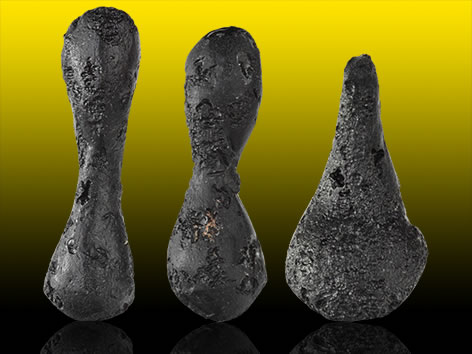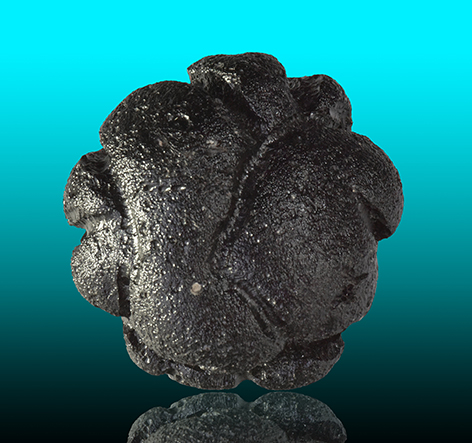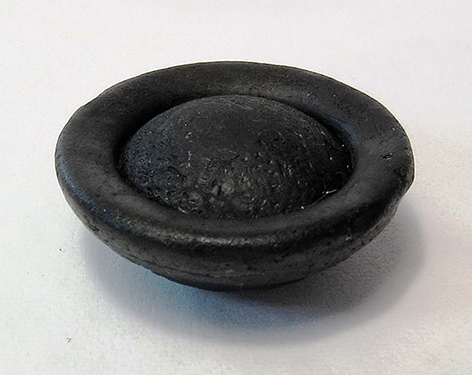Agnimanitite
Colombianite
Tektites China
Darwin Glass
Libyan Glass
Moldavites, Czech Republic
Rizalites, Philippines
Tektites, Thailand

Dumbells & Tear Drop
Maoming,
Guangdong,
CHINA
Agnimanitite
Colombianite
Tektites China
Darwin Glass
Libyan Glass
Moldavites, Czech Republic
Rizalites, Philippines
Tektites, Thailand

Dumbells & Tear Drop
Maoming,
Guangdong,
CHINA


AUSTRALITE
Flanged Button
Port Campbell,
Victoria,
AUSTRALIA
DARWIN GLASS Darwin Glass is believed to be a stone of knowledge and spiritual development. Like all Tektites, Darwin Glass is a great protection stone, particularly when one is having trouble picking up strong emotions from all those around when a protective shield is required. Darwin Glass creates a protective bubble around one that allows one to remain peaceful and calm as one filters all the information one is being bombarded with and process it in an objective way. Zodiac Sign: Taurus and Sagittarius |
Eastern Sahara, EGYPT Libyan desert glass or Great Sand Sea Glass is an impactite, made mostly of lechatelierite, found in areas in the eastern Sahara, in the deserts of eastern Libya and western Egypt. Fragments of desert glass can be found over areas of tens of square kilometers. Egyptians discovered Libyan Desert Glass thousands of years ago. It was prized for jewellery and amulets. The origin of desert glass is uncertain. Meteoritic origins have long been considered possible, and recent research links the glass to impact features, such as zircon breakdown, vaporized quartz and meteoritic metals, and to an impact crater. The glass is nearly pure silica which requires temperatures above 1,600 °C to form – hotter than any igneous rock on Earth. However, few mineral relics survived from whatever caused the melting, including a form of quartz called cristobalite, a rarely occurring high-temperature mineral; and grains of the mineral zircon, although most have reacted to form a higher-temperature mineral called zirconia. Ideas about how the glass formed include melting during meteorite impact, or melting caused by an airburst from an asteroid or other object burning up high in Earth's atmosphere. Abstract– Dark streaks and different types of inclusions in Libyan Desert Glass (LDG) collected from the LDG strewn field in Egypt were investigated. Rare transparent spherules enclosed in the glassy matrix are characterized by concentric cracks, irregular internal cracks, intense twinning, and considerable amounts of Ti and Al. Raman spectra show that the spherules are α-cristobalite. Their occurrence together with lechatelierite indicates quick heating of the source rock to at least 1550 °C, followed by rapid quenching leading to crystallization of β-cristobalite, which upon cooling inverted into α-cristobalite. Brownish inclusions are irregularly shaped, elongated objects with smooth contacts to the surrounding glass. They contain small roundish to elliptical droplets, and a few larger angular grains, which compositionally and according to their Raman spectra most closely resemble low-Ca, Al-rich orthopyroxene. Composition and texture of the orthopyroxene suggest that the brownish inclusions formed by incomplete melting of an Al-rich orthopyroxene bearing precursor, e.g., mafic phases present in desert surface sands or also of orthopyroxene-bearing granulite dykes in the LDG target. Experimental data on Ca-poor enstatite also support that the inclusions were heated to about 1550 °C. Analyses of dark streaks in LDG reveal high abundances of Al, Ti, Mn, Cr, Fe, and Ni and a pronounced correlation between the abundances of Cr, Mn, Fe, and Ni. As the Fe/Ni, Mn/Ni, and Cr/Ni ratios are all clearly nonchondritic, the source of this material is most likely terrestrial and the dark streaks studied here represent a different type of schlieren compared to those which contain a meteoritic component. These findings suggest LDG formation during a short high-temperature event. Melting of Al-rich orthopyroxene bearing target material seems to suggest an asteroid impact rather than a near-surface airburst.
Libyan Desert Glass (LDG) is an unusual natural glass that occurs in large quantity between the sand dunes of the southern region of the Great Sand Sea of southwest Egypt. The irregularly shaped, millimeter- to several decimeter-sized, and often wind-eroded fragments are scattered over almost 6500 km2, although the main distribution is limited to about 2000 km2. The largest samples recovered so far weigh up to 26 kg. The fragments generally appear light-yellow to greenish in color, although some pieces are white due to abundant tiny bubbles, and, in a few rare cases, contain some dark streaks. The angular fragments were used over thousands of years during prehistoric and dynastic Egyptian times to produce a variety of artifacts, such as the yellow/green scarab of Tutankhamen’s pectoral (De Michele 1998).
Metaphysical Healers It is also said that it enhances energy levels and supports the immune system. Its vibrant energy revitalises the body and promotes overall well-being. It stimulates creativity unlocking creative innovations and expands mental capabilities.
|
TEKTITESiO2+Al2O3+Ca, Fe, Sr, Mg, Na, BaCrystal: Amorphous Hardness: 5 - 6 Sp.G.: 2.34 - 2.51 Cleavage: None Fracture: Conchoidal Colour: Clear, Black, Brown, Green |
|---|
|
TEKTITES are gravel-size bodies composed of black, green, brown or grey natural glass formed from terrestrial debris ejected during meteorite impacts. The area impacted by the meteorite immediately melts and debris is splashed out in all directions, in some cases leaving the atmosphere. As the debris falls back to earth it partially remelts and forming a variety of shapes, which are often pit marked.
Tektites have been found only in certain parts of the world, spread over large areas called ‘strewn fields’, mainly in low latitudes. The three major areas are south-east Asia (especially Thailand and the Philippines), Australasia; Caribbean-North America; and Ivory Coast, West Africa. Many varietal names are given to Tektites from different localities.
Tektites are named geographically, i.e. Australites (Australia), Indochinites (Thailand & Cambodia), Thailandites (Thailand), Philippinites and Rizalites (Philippines), Javaites (Java), Billitonites (Billiton Island, Indonesia), Moldavites (Vltavins) from the Czech Republic and Slovakia, Bediasites (Texas, U.S.A.).
After falling back to Earth as showers of glass, many tektites lay exposed to weathering and erosion at the surface or shallow depth.
The Australasian Strewn field is the youngest and largest of all the Tektite strewn fields, covering 10% to 30% of the Earth’s surface, and is believed to be about 790,000 years old. There are 26 known impact craters less than 1 million years old all around 2 Kilometres across, but it has been proposed that a much larger impact crater would have been necessary to create such a large strewn field. Suggested locations are Mekong Valley in Southern Laos and Cambodia as possible sites. However, near the Mekong River in southern Laos there’s a Delaware sized plateau. Volcanic eruptions have created lava beds up to 1,000 feet deep. The scientists realised that’s thick enough to hide a large crater. The hunt is on. Tektite form in many shapes, ovals, rounds, spheres, teardrops, dog biscuit and dumbbells. Some Australites are quite unique having a flange button but are extremely rare.
Where to find Tektites in Australia? Many thousands of Australites have been washed into shallow lakes or depressions and are now found on claypans, and shallow drainage depressions. Australian tektites (Australites) have been known and used as artefacts and ritual objects by Aboriginal Australians for over 30,000 years. The earliest record of scientific study of Australian tektites is a Darling Downs, Queensland specimen given to Charles Darwin in 1836, when he visited Sydney on board the Beagle. Emus have been known to swallow Australites for gizzard stones which help grind up their food.
Glassy, molten rocks can also be produced directly by the high heat and pressure of a meteorite impact or just its shock wave, without projecting the molten material up into our atmosphere. Molten glass and rocks fractured by high pressure have been found near impact craters and are called impactites.
The Ries Crater in southern Germany has molten rocks containing high pressure forms of silica, while other sites have 'shocked' quartz showing strain and fracturing, pulverised rock flour and shock breccia (rock fragmented and compacted by shock). Sometimes a yellow glass made from fused quartz sand is found in desert areas, 'Libyan glass' from the Libyan desert being a well-known example. Such examples are probably a result of an impact, but there may not be direct evidence of associated craters. In the Northern Territory of Australia, small rounded pieces of frothy, molten rock have been found at the Henbury craters, and rocks fractured into a regular 'shatter cone' pattern by intense, sudden pressure have been found at Gosses Bluff impact crater. Mt Darwin crater near Queenstown, Tasmania has molten glass (' Darwin glass') very much like tektites, but it has probably not travelled through our atmosphere.
Tektites have been carried as a Talisman by ancient people as a protective stone. Metaphysical Healers say that, physically, Tektites enhance and accelerate healing from illness and injuries. Sleeping with a Tektite under the pillow can also be emotionally calming. Please do your own research before using tektites a a natural remedy.
Zodiac: Aries, Cancer, Sagittarius |
Please read our DISCLAIMER
Stone of Wisdom or "Philosopher's Stone” Colombianites are a sacred stone to the Indians from the Muisca tribes and are considered a stone of divine energy. The natives call them "Piedra Rayo," which means "Lightning Stone." The Geology Department (University of Ljubljana) and the Museum of Natural History, extensively compared different types of Tektites. Interestingly, it has survived an incredible 30 million-year era (Obsidian is very unstable and rarely exceeds a few million years). It is a transparent, Natural, Highly Energetic Gem. Much rarer than Moldavite and Saffordite. Metaphysical Healers say Colombianites are a powerful instrument in raising human consciousness. They are used to balance oneself and bring into alignment your innate gifts. Connected to the Third Eye and Crown Chakras, Colombianites help one seek spiritual solace and illumination. Colombianite is considered a sacred stone for humanity, helping to reignite the spiritual fire within each of us. Through this, we raise our vibration connecting us to the upper spiritual realms. This stone helps us to channel and ground the high-vibration messages and information that come through as we work with them. Colombianite helps us to dissolve negative thought forms, emotional blockages, and outdated belief systems, so one must be prepared to release the old debris. It helps us to expand cosmic consciousness, love, light, and grace, creating peace and harmony not only within the self but with life and one's relationships. This rare and precious Stone has a very high vibration compared to other Star Stones. Those destined to have it will gain the opportunity to experience deep Compassion through the Divine Mercy. They can trigger clear images and deep emotions. The visions were followed by Tears of Awareness and Recognition of the Truth on a higher Emotional and Spiritual level. They are intended for people with a Higher Spiritual mission. Colombian Healers use it for communication with the invisible.
|
|
for displaying and protecting your favourite minerals, gems, fossils, meteorites or other collectibles. We also make mineral display stands and acrylic blocks. FOLLOWING LINK BELOW: And DISPLAY PRODUCTS |